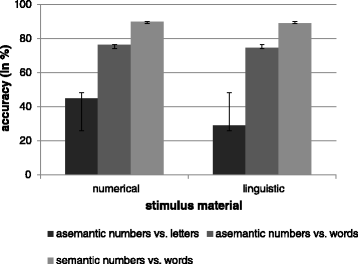Patterns of linguistic and numerical performance in aphasia
- PMID: 25648216
- PMCID: PMC4331419
- DOI: 10.1186/s12993-014-0049-1
Patterns of linguistic and numerical performance in aphasia
Abstract
Background: Empirical research on the relationship between linguistic and numerical processing revealed inconsistent results for different levels of cognitive processing (e.g., lexical, semantic) as well as different stimulus materials (e.g., Arabic digits, number words, letters, non-number words). Information of dissociation patterns in aphasic patients was used in order to investigate the dissociability of linguistic and numerical processes. The aim of the present prospective study was a comprehensive, specific, and systematic investigation of relationships between linguistic and numerical processing, considering the impact of asemantic vs. semantic processing and the type of material employed (numbers compared to letters vs. words).
Methods: A sample of aphasic patients (n = 60) was assessed with a battery of linguistic and numerical tasks directly comparable for their cognitive processing levels (e.g., perceptual, morpho-lexical, semantic).
Results and conclusions: Mean performance differences and frequencies of (complementary) dissociations in individual patients revealed the most prominent numerical advantage for asemantic tasks when comparing the processing of numbers vs. letters, whereas the least numerical advantage was found for semantic tasks when comparing the processing of numbers vs. words. Different patient subgroups showing differential dissociation patterns were further analysed and discussed. A comprehensive model of linguistic and numerical processing should take these findings into account.
Figures
Similar articles
-
The influence of event-related knowledge on verb-argument processing in aphasia.Neuropsychologia. 2015 Jan;67:63-81. doi: 10.1016/j.neuropsychologia.2014.12.003. Epub 2014 Dec 5. Neuropsychologia. 2015. PMID: 25484306 Free PMC article.
-
Appraising Linguistic and Reading Impairments in Kannada-Speaking Persons With Central Alexia.Cureus. 2024 Jun 29;16(6):e63437. doi: 10.7759/cureus.63437. eCollection 2024 Jun. Cureus. 2024. PMID: 39077278 Free PMC article.
-
Grammaticality judgments and sentence comprehension in agrammatic aphasia.J Speech Hear Res. 1988 Mar;31(1):72-81. doi: 10.1044/jshr.3101.72. J Speech Hear Res. 1988. PMID: 3352257
-
Short-Term Memory and Aphasia: From Theory to Treatment.Semin Speech Lang. 2017 Feb;38(1):17-28. doi: 10.1055/s-0036-1597261. Epub 2017 Feb 15. Semin Speech Lang. 2017. PMID: 28201834 Free PMC article. Review.
-
Evaluating the distinction between semantic knowledge and semantic access: Evidence from semantic dementia and comprehension-impaired stroke aphasia.Psychon Bull Rev. 2020 Aug;27(4):607-639. doi: 10.3758/s13423-019-01706-6. Psychon Bull Rev. 2020. PMID: 31993976 Review.
Cited by
-
Decoding visual fatigue in a visual search task selectively manipulated via myopia-correcting lenses.Front Neurosci. 2024 Apr 10;18:1307688. doi: 10.3389/fnins.2024.1307688. eCollection 2024. Front Neurosci. 2024. PMID: 38660218 Free PMC article.
-
Lesions that do or do not impair digit span: a study of 816 stroke survivors.Brain Commun. 2021 Mar 10;3(2):fcab031. doi: 10.1093/braincomms/fcab031. eCollection 2021. Brain Commun. 2021. PMID: 33928246 Free PMC article.
References
-
- Gross J, Hudson C, Price D. The long term costs of numeracy difficulties. London: Every Child a Chance Trust and KPMG; 2009.
-
- Dowker A. Individual differences in arithmetic. Implications for psychology, neuroscience and education. New York: Psychology Press; 2005.
-
- Parsons S, Bynner J. Does numeracy matter more? London: National Research and Development Centre for adult literacy and numeracy; 2005.
-
- Henschen SE. Ueber Sprach, Musik und Rechenmechanismen und ihre Lokalisationen im Grosshirn. Zschr gesamte Neurol Psychiatr. 1919;52:273–98. doi: 10.1007/BF02872428. - DOI
Publication types
MeSH terms
LinkOut - more resources
Full Text Sources
Other Literature Sources
Medical


